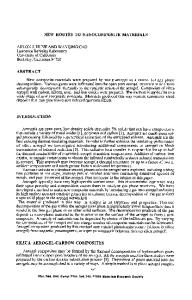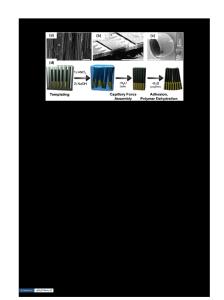Routes to Diamond Heteroepiitaxy
- PDF / 3,105,325 Bytes
- 11 Pages / 420.48 x 639 pts Page_size
- 60 Downloads / 469 Views
ROUTES TO DIAMOND HETEROEPIITAXY
ANDRZEJ BADZIAN AND TERESA BADZIAN Materials Research Laboratory, The Pennsylvania State University, University Park, PA 16802
ABSTRACT This paper reviews the status of diamond heteroepitaxy approached by chemical vapor deposition and by physical methods. Reported are experiments with cubic boron nitride and nickel conducted with the help of microwave plasma chemical vapor deposition. X-ray diffraction data confirm diamond heteroepitaxy on the (111) faces of cubic boron nitride crystals. Heteroepitaxy on nickel was not demonstrated yet nevertheless suppression of graphite nucleation was achieved by formation of nickel hydride.
HINTS FOR HETEROEPITAXY Heteroepitaxial growth is a common practice for the family of ArBV and A"B"v semiconductor compounds and elements like Si and Ge. This has been achieved by several growth methods, such as molecular beam epitaxy, metallorganic CVD, growth from solutions and others. Demonstration that homoepitaxial growth of diamond by CVD is feasible allows us to expect that diamond heteroepitaxy should be attainable because of the analogy of diamond to these other semiconductors. Till now this expectation did not materialize with one exception - heteropitaxial growth of diamond on micrometer size faces of cBN crystals. Heteroepitaxial growth means that on the surface of single crystal A (over macroscopic area) another crystal B starts to nucleate and grow with the specific crystallographic orientation relationship between A and B crystals, which corresponds to some kind of lattice matching. The lack of perfect matching at the interface introduces a strain between these semicrystals. The strain is relaxed in specific ways. For example, when the crystal A is silicon and the crystal B is silicon doped with boron, misfit dislocations are formed just above the interface. This formulation of heteroepitaxy does not consider any transition interlayer between A and B, but instead direct chemical bonds are formed between atoms of the crystals A and B. In the sense formulated above heteroepitaxy of diamond was not documented despite years of trials using a whole spectrum of substrates. However, there is some evidence that diamond was grown heteroepitaxially on the (111) face of cubic BN crystal over an area of -10g.tm by direct current plasma CVD [ 1]. Cubic BN is the first candidate to study heteroepitaxy because of its good lattice matching (1.4% mismatch) and its solubility with diamond. The formation (under high pressure) of substitutional solid solutions between diamond and cubic BN indicates the formation of chemical bonds between B, C and N [2]. The first report on diamond heteroepitaxy on micrometer size cBN grit was presented by W. Yarbrough, A. Kumar and R. Roy [3,4]. Scanning Electron Microscope observations on diamond growth on cBN crystals support epitaxial growth [5,6]. Some information on heteroepitaxy can be extracted from studies of inclusions in diamond crystals. X-ray diffraction techniques have revealed for some mineral inclusions in natural
Data Loading...










